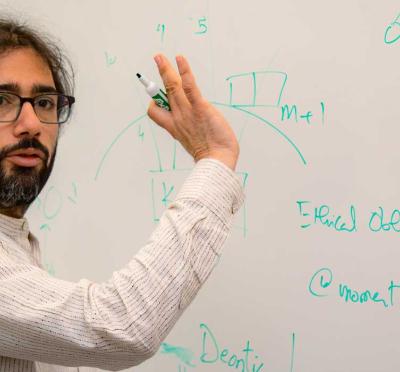Oregon State Engineers are developing a new generation of energy storage and production technologies that could shake up the solar power landscape. One induces algae to produce half its weight in clean-burning biofuels, while another could yield inexpensive, flexible rooftop solar panels. A third might power entire cities, and a fourth will store vast amounts of solar-generated power indefinitely at low cost.
BANKING SOLAR ENERGY
Nick AuYeung’s research into thermochemical energy storage, or TCES, could pave the way for an elegant system that stores solar energy indefinitely.
In one model of TCES under investigation by AuYeung, assistant professor of chemical engineering, solar-heated air is forced through a bed of mixed metal oxide particles, which initiates a reversible endothermic reaction. As the metal oxides heat up, they release oxygen and store the solar energy in newly formed chemical bonds.
To discharge the stored energy, the reaction is reversed. Pressurized air is sent back through the bed of metal oxides, which absorbs its lost oxygen and releases heat. The passing air absorbs the heat and can then then flow into the turbines of a commercial power station. Variations on TCES systems using different media and different charging techniques might one day become practical on a small scale in homes for heating water or space heating.
One of the main benefits of TCES is that the amount of captured energy doesn’t diminish as the storage medium cools. That means it can be stored for long periods of time and tapped as needed. The feature will be especially useful during periods of low solar intensity. By comparison, energy collected by solar-thermal systems must be used before the medium cools down, and energy from photovoltaic cells must either be used immediately or stored in batteries, which have issues with cost and scaling.
AuYeung and his team are now evaluating the energy density of various storage media and their longevity after multiple charging and discharging cycles.
THE HOTTER, THE BETTER
If all goes as planned with Oregon State’s prototype solar power receiver, concentrated sunlight collected by a 9-meter parabolic mirror will heat carbon dioxide flowing through the device to 720 degrees Celsius at 250 bar of pressure. At such extreme conditions, the CO2 becomes supercritical — a state in which it exhibits properties of both a gas and a liquid.
The receiver itself is one of the central components in a solar-thermal power generating system. According to Brian Fronk, assistant professor of mechanical engineering and the project’s principal investigator, one of the major challenges has been developing materials that can contain a fluid at temperatures and pressures that would melt steel like butter.
Current solarthermal power systems that use steam or molten salt can reach about 500 C. The high temperatures that Fronk and his multidisciplinary team want to attain could translate into far greater efficiency (and lower costs) for producing electricity compared with competing solarthermal technology.
Higher operating temperatures are also necessary to make solar-thermal systems compatible with Brayton cycle power plants. The Brayton cycle is a thermodynamic process that describes how gas turbines operate. The U.S. Department of Energy is interested in supercritical CO2 Brayton cycle technology and has funded Fronk’s research through the Solar Energy Technology Office.
The agency’s interest in the technology stems from its potentially high efficiency, smaller equipment footprint, and decreased need for water cooling, which is an attractive feature for desert-based power plants.
A scaled-up, operational version of the supercritical CO2 system would look similar to existing solarthermal systems: a tower-mounted receiver surrounded by a field of mirrors. The CO2 would travel either through conduits to below-ground storage or directly into turbines to generate electricity.
Fronk anticipates modular facilities, each composed of multiple supercritical CO2 solar power generators, which could be scaled up to produce 300 megawatts of solar-thermal energy. That’s enough to power approximately 100,000 homes. Additionally, solar-thermal energy can be stored more efficiently than wind-generated or photovoltaic electricity, which for now makes it an important value proposition.
MICROSCOPIC REFINERIES
Powered by sunlight and drawing nutrients and carbon dioxide from water, diatoms, a common type of algae, naturally produce lipids that can be converted to biofuels, like biodiesel and even jet fuel. Greg Rorrer, professor of chemical engineering, and his research team figured out how to induce the single-celled organisms to overproduce these lipids by manipulating their silicon uptake. Their breakthrough potentially makes diatoms a viable commercial source of advanced biofuels and other products.
Diatoms are encased in a rigid, translucent cell wall — a frustule — composed of opaline silica that the organisms assemble from dissolved silicon they absorb from surrounding water. The more silicon they have access to, the more the diatoms divide and increase their population. When starved of silicon, however, they stop dividing and produce lipids instead.
With support from a $2 million grant from the National Science Foundation through the Emerging Frontiers in Research and Innovation Program, Rorrer created the best of both worlds for lipid production: He supplied enough silicon so that the diatoms multiplied. But he carefully controlled the rate at which it was introduced and duped the organisms into sensing that they were being deprived of the critical element.
In some cases, Rorrer was able to coax the diatoms in his lab to produce more than 60% of their weight in lipids — far more than their natural output.
Rorrer, who is also goading diatoms into producing chitins — nanofibers widely used in biomedical applications — likens the organisms to tiny factories able to transform raw materials into valuable commodities. He envisions large-scale production of these commodities at diatom farms, where light, nutrients, and other inputs are carefully controlled to yield optimal outputs.
SHAPING A NEW CLASS OF SOLAR PANELS
The cost of photovoltaic solar cells has fallen steadily for more than two decades, leading to widespread use of the technology by businesses and homeowners. John Labram, assistant professor of electrical and computer engineering, is working on technology that could result in dramatic price drops and further reduce our reliance on fossil fuels. His research is supported by Oregon State University startup funds and teaching assistantships.
Labram is particularly interested in solar panels whose light-harvesting layer contains a class of materials called metal halide perovskites instead of silicon. Perovskites are a collection of compounds with optical and electronic properties (and efficiency) similar to those of crystalline semiconductors. But because perovskite cells are much cheaper to produce, they have the potential to change the economics of solar power.
Solar cells made with perovskites, however, present some challenges, including the fact that, unlike with silicon-based solar cells, the performance of solar cells made of perovskites declines sharply when they’re exposed to atmospheric moisture.
One way to improve the stability of perovskite solar cells is encapsulation, in which waterproof polymers or glass protects the entire assembly. Labram’s group, however, focuses on techniques for improving the stability of the material itself, such as modifying its chemical composition, changing its microstructure, and including specific additives in precursor solutions.
Labram anticipates that research like his will ultimately lead to commercially viable perovskite solar panels. He even envisions perovskite systems so cheap and flexible that they can be produced on commercial-scale printers and rolled out across entire rooftops. He also expects that perovskite solar panels will one day become a lower-cost alternative to current photovoltaic systems.



